Tweed. noun.
Acronym of: That’s What Everyone Else Does.
Something that has been copied without purposeful strategy or thought.
We humans are born imitators. It’s how we learn, it’s how we socialise, it’s how we entertain ourselves. In fact, our very existence is owed to our DNA’s ability to make copies of itself.
The way creatives learn their craft is to study the form and function of other people’s work, before applying those understandings to projects they are working on. In other words, they copy, tweak, modify and publish.
This, of course, is all perfectly natural and normal; except for one very significant point:
If you want to stand out, you have to be different.
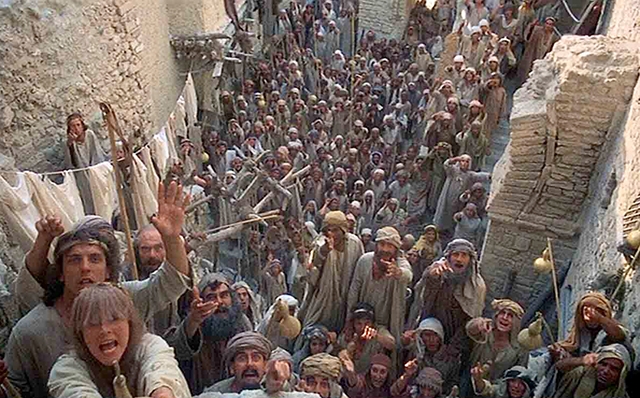
In an over-saturated market, standing out is mandatory. People cannot choose you over your competitors if they can’t tell you apart.
The trouble is, “being different” scares the willies out of people. They remember what happened to the last tall poppy who dared to poke their head above the crowd.
The more politically minded will recognise it as bad strategy, as it clearly identifies you as the source of blame should things go pear-shaped. The best plan to mitigate backlash is to have mistakes spread over as many people as possible, and that is achieved by fitting in.
Tweed is more than merely one company copying its opposition, tweed reflects the management’s overwhelming fear of failure; leading to the practice that any given idea can’t be any good unless it can be shown that someone else has tried it and it has worked for them.
Specifically, tweeds are single (often misattributed) aspects of another organisation’s success. The thinking is that the same tweeds applied to another company will generate similar results.
Mission statements, logos, taglines, websites, Facebook and twitter accounts are all examples of tweed in corporate marketing.

Production Techniques
Tweeds are often fads, spreading virally through any creative community you care to think of. You see it particularly in advertising where, in the absence of any actual ideas, whole campaigns are pitched and won on nothing but a pile of production techniques stolen from other ads.
Which is why I freaking love this next spot.
I have no idea how serious the makers of this ad were when they made it; but frankly, I don’t care. If I lived in the Ayrshire district in the UK, and required the services of a travel agent, I would definitely visit them on the strength of this, um, piece of content. So… well done guys.
Sadly, the original spot is no longer available. This, I’m guessing, is the result of the internet commentary shitstorm this spot created. All that’s left are second generation copies on [mostly humorous] websites.
Let’s list those techniques, shall we?
• popular music track, (no matter how bad a fit)
• black and white to colour transition
• flying colour strips
• particle generator swooshes
• before/after “storytelling”
• choreography [including a dude in a dress doing parkour]
• slow-mo/ramp speed/jump cuts
• “magic time” transitions
• crane shot pullback
• pyrotechnics
Seriously, this spot is just one budget boost away from being almost identical to many ads and TV promos on air today.
So, you might be thinking: if the spot does its job and makes you want to visit the travel agency, why are you picking on it? Wouldn’t an image spot to launch a television show that uses the same techniques be as good?
Well… no.
Once maybe. But not for every. single. launch.

Light Leaks
The blending of colourful light textures into images to simulate film that has be exposed to a secondary light source before developing. Light leaks give pictures a summery, retro feel.
Currently in high use, they are effectively The Bedazzler of the promo world.


“Fonts”

I always thought that a font was the object placed into the printing machine; and the typeface was the design of the lettering upon the font. Maybe I’m wrong.
In any case, “fonts” are definitely tweedy. Gotham seems to have run its course, with DIN replacing it. Futura Condensed is making yet another comeback.

Artisanal Logos
Once a certain look takes a foothold, you start seeing it everywhere.

Check out an ace bit of hipster tweed exposing from Tim Delger!

The Fingernail Clipping
The Fingernail Clipping is just so outrageously everywhere in logo design. Here are just a handful examples:

There are, of course, plenty of other design fads, but there’s something just so incredibly contagious about the dreaded fingernail.

The Latest Plug-In
Some software company releases a new plugin; and suddenly it’s everywhere. Even if there’s no real reason for it be used, ad people just bend the brief to suit the latest hot look.
I know this next product is called Smoke Vodka. But isn’t that more about the flavour of the drink, and less about what it will do to your brain cells?
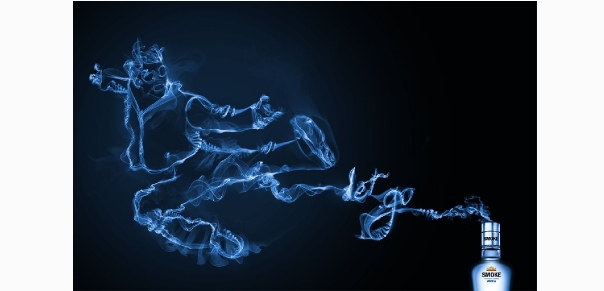
I guess the real problem is not that clients pay for this “creative service”, nor is it that these ads win awards… it’s just that they don’t really mean anything to the reader.
Sometimes they can be just plain old silly, like this ad for After Dark Condoms:

I dunno ’bout you, but if your rubber starts smoking, you might need to go buy some lubricant.

Trailer Tweed
You know what you do has become a cliché when it becomes the subject of parody. But when the parody reaches the heights of this amazing trailer spoof it’s time to hang your head in shame. I’m talking to you Hollywood Marketing Machine.
These great spots are absolute must-see viewing:

Hollywood movie naming rule
Hard-up for a title for your film or TV series? Fear not! Try Hollywood’s patented movie naming rule. Simply write down the name of the story’s main character; then before that, place the active verb that best describes what they are trying to achieve in the story. Voilà! You got yourself a whole bunch of tweed at the movies.

I was inspired here by French dude Christophe Courtois, who has compiled a stack of theatrical movie posters and sorted them by cliché category to produce an OCD view of tweed at the movies writ large.
Nice work, frè. Check out Christophe’s blog here

The Wilhelm Scream
A sound effect that pops up in literally dozens of movies. It’s not really tweed anymore, because it is now being placed in movies very deliberately. I just like it, I guess. Read more about it here, and/or watch this:

The Fallacy of the Obedient Sponge

The deeply flawed belief in advertising that people absorb and memorise everything they see; and, will do/think/feel/believe whatever they are told for no other reason than they are being told to do it.

The Social Media bandwagon
The belief that a company’s participation on social media will instantly deliver new customers and satisfy existing ones, all for a fraction of the cost of real marketing.
There was a very, very brief moment of opportunity when real people did respond to social media advertising and marketing campaigns, simply because it was all so new. Those days ended almost as soon as they began.
Today, social media is merely just another channel through which businesses can communicate with people. And, as with every other channel, the level of customer engagement depends on the quality and consistency of the entertainment/education/information produced for the channel.
Certainly, use of social media can cut media placement costs considerably; but not completely. Moreover, social media can only ever reach people who are actively participating on social media, a group which is anything but comprehensive. In any case, regular users train themselves awfully quickly where the good content on a webpage is and simply ignore everything else.

The packaging heist
The copying of a successful brand’s packaging with the view of having that success rub off on your brand.
As part of the presidential campaign of 2008, Barack Obama introduced several iconic graphic elements, including the dynamic “O” logo. Since his victory, the logo has been stolen by other political parties around the world. (I’ve personally seen it in Italy and South Africa). But do marketers really think people voted for Obama because he had a nice logo?
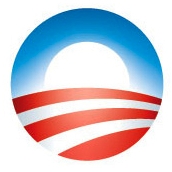
Apparently, the answer is: Yes! In fact, so much has been written about the Obama Logo (go ahead and Google it) that you’d think it was the only reason for his success.
You’ll notice I very specifically avoided the term ‘branding’ here; something that people mistake for packaging. Branding is something else entirely to just slapping a logo everywhere.

No Tagline Is An Option
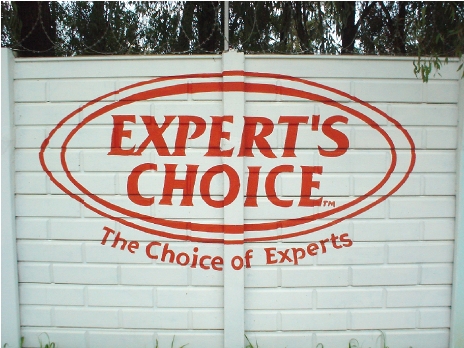
Before we begin. Yes, this is ad is for real. I snapped this picture in Johannesburg, South Africa. It was part of a series of ads painted on a brick wall that formed a compound around what I think was some kind of animal sanctuary. I dunno. There are a lot of compounds in Johannesburg.
But if you think this is plain silly, compare it with your company’s existing tagline.
Taglines or straplines or positioning lines (or whatever they are called) are used by companies to try and explain what their business is about; or exclaim some kind of quality. Their use is textbook tweed..
We can see that an opportunity has been lost with Expert’s Choice.
Perhaps a better tagline would be:
“Expert’s Choice – The Dog Food Vets Recommend”.
At least this would explain whatever the hell Expert’s Choice is.
(BTW: I still don’t know.)
The point is: if your company name already explains what you do, why have a tagline at all? No tagline is an option.
If you’ve attended my Branding Seminar you know I hate taglines that attempt to literally state a company’s proposed brand values… as if people will simply believe that your company is whatever you say it is.
I accept that there are times your company will just have to be married to a tagline. But just as long as it doesn’t explain the obvious.

This ad topped a huge outdoor LED TV screen that played sporting events over summer. I doubt that the handful of people who actually used this facility had any trouble understanding what Cellarbrations were in business to do.
The same minds who came up with this name for their business must have thought their pun a bit too cryptic for people who like to drink and watch sport in shopping malls. Again, the tagline here is a wasted opportunity to try to explain why someone might stop buying booze at the supermarket and start going to Cellarbrations instead.
I think 90% of tagline usage comes down to plain, old lack of confidence. Apparently you can’t just be the things you want to be and risk people will get it… apparently you have to tell them.
Imagine a guy going out for a night on the town, hoping to get lucky. He knows he’s funny and smart. But just to be on the safe side, he decides to wear a t-shirt:

Yeah! That oughta do the trick!
He who would pun, would lop a locket
It seems you can’t start a new hairdressing salon without including a pun in the name. Sure, there are any number of hairdressing salons that sound like they could be nightclubs: Extremes. Vertigo. Sensations… But the punny ones are the pits. Some examples include:
1/. Hairacy
2/. Hair Force
3/. Do or Dye
4/. A Cut Above
5/. Headhunters
6/. Public Hair
7/. Lunatic Fringe
8/. Hairway to Heaven
9/. Headonism
10/. Julius Scissor
Perhaps this is what looking at the top of people’s heads all day does to you. (Maybe the same goes for cooking Thai food?)
You can see an extensive list on Flickr here.

How to say: a billion
TV Journalists, your attention please. Because a million and a billion sound so alike; and because a billion is just so much more than a million; it is vital that when saying a billion, you must pause before the word billion, and then place an explosive “B” at the front of it.
You can’t just say something like:
“The new freeway will cost taxpayers seven billion dollars”.
Nowhere near good enough. You must say:
“The new freeway will cost taxpayers seven… BILLion dollars!”
Make sure you also shake your head from side to side in disbelief or amazement.

Tweed at the Airport
Tweed is never as easy to spot than when people are forced together. When those crowds get a little anxious you just can’t miss it. Why is it that the instant the plane pulls up at the gate, everyone immediately stands up?

It’s not unusual for people to be standing 5 to 10 minutes before they actually are able to exit the aircraft. Perhaps people think that the cabin crew will forget to open the doors? Once inside the terminal, why is it that people crowd the baggage carousel?
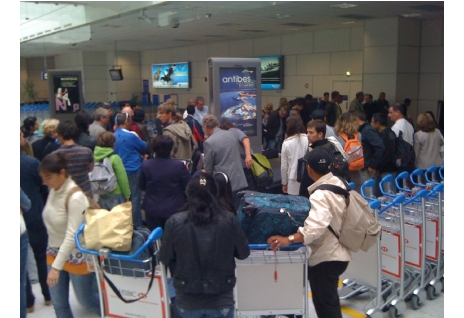
It’s not going to make the bags arrive any faster, is it?


